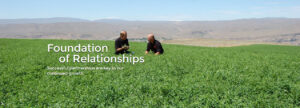Does Steaming Make Hay Healthier and Safer for Horses?

Soaking hay in water for 30 minutes or less is a good way to reduce airborne particles such as dust and mold, making it an effective management strategy for horses with respiratory problems. Soaking also reduces levels of nonstructural carbohydrates in hay, which is essential for horses with metabolic issues. However, soaking also leaches other essential nutrients from hay.
Steaming hay before feeding is commonly practiced in Europe and is becoming more popular in the U.S. But, not much is known about the effects of steaming on the nutritional quality of forage and if it effectively reduces dust and mold in hay. Fortunately, a study to examine the effects of steaming on hay quality was recently conducted by a team of researchers based in the Department of Animal Science at the University of Minnesota.
The team obtained two different lots of alfalfa-orchard grass hay that were harvested at different moisture levels. The hays had similar nutritive values, but differed in mold concentrations. One lot contained low levels of mold (LM) and the other was moderately moldy (MM). Each day one bale each of LM and MM hay was steamed for 90 minutes. Samples were taken to assess the nutrient composition, number of dust particles, and mold content of the hays before and after steaming.
Six horses were used in a 10-day crossover design. Three horses were randomly assigned to each hay type (LM or MM) on the first day of the experiment. On the sixth day, hay types were switched. Each day of the trial, horses were simultaneously offered two flakes of steamed and two flakes of unsteamed hay from the same hay type (LM or MM). They were housed in stalls and allowed to eat for two hours. After the test period, the horses were removed from their stalls and hay consumption during the two-hour period was determined by weighing the remaining hay.
The unsteamed MM hay had higher amounts of suspended particles (dust) and mold than the LM hay. Unsurprisingly, steaming increased the moisture content of LM and MM hays (33% and 29%, respectively). Levels of crude protein, fiber, starch, and calcium were not affected by steaming. In comparison, phosphorus and mold count were reduced in both hay types after steaming. Levels of water soluble carbohydrates, ethanol soluble carbohydrates, and dust particles were decreased by steaming in MM hay, but not in LM hay.
Steaming LM hay increased dry matter intake during the two-hour test period while intakes of the MM hay were not affected by steaming. Steaming kills viable mold, but does not physically remove it. If mold has an unpleasant taste, killing it will not improve palatability, which would explain why steaming did not increase intakes of MM hay.
Treating hay with steam reduced mold concentrations in hay. However, intakes were improved only when hay initially contained low levels of mold. Steaming hay may be a useful management strategy for horses that are picky eaters, have poor teeth, are malnourished, or are recovering from surgery. However, hay steamers are still quite expensive; therefore, soaking might be a more cost effective method to reduce dust, mold, and nonstructural carbohydrate concentrations in hays for horses with respiratory and metabolic conditions.
To receive this blog from Anderson Hay directly in your email, subscribe above on the right.
Reference
Earing, J.E., M.R. Hathaway, C.C. Sheaffer, B.P. Hetchler, L.D. Jacobson, J.C. Paulson, and K.L. Martinson. 2013. Effect of hay steaming on forage nutritive values and dry matter intake by horses. J. Anim. Sci. 91:5813-5820.


